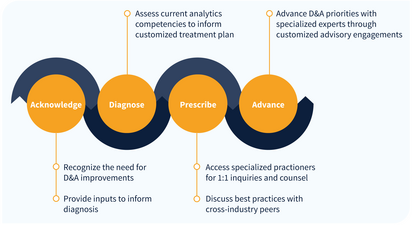Client Inquiry:
I have recently been hired as an enterprise data science lead and am responsible for creating and determining what our data science team roadmap will look like. I've been requested to identify revenue/cost savings of many opportunities, set priorities, and communicate the benefits.
How can you estimate and measure data science impact in the organization and deliver that value to management and stakeholders? How can you adopt data science and measure the impact before the projects have even started? How to determine what projects will hold the most value for the company? What is your experience in setting priorities and measuring value/impact?
Expert Takeaways:
1. Collaborate with Finance
Finance has a uniquely comprehensive view of cost, revenue, and ROI—and they’re already speaking the language you’ll need to justify your roadmap. Collaborating with them helps quantify potential opportunities at a high level, align with executive priorities, and make your proposals more credible.
- Finance can help you size the opportunity across domains—so you can compare the ROI of a 1% improvement in chemical procurement vs. a 1% improvement in labor efficiency.
- High-level “napkin math” is enough to begin filtering your backlog: what’s big enough to matter, visible enough to be recognized, and aligned enough to be prioritized?
- Strategic goals like “cost savings” or “efficiency” are too vague to be useful on their own—almost everything qualifies. Instead, look for areas where finance already tracks impact and can co-own the value case.
- Even if some areas are bigger financially, prioritize where there’s already engagement and curiosity—you’ll get faster traction and stronger proof points.
2. Start with Conversations, Not Use Cases
Relationships surface problems that dashboards can’t. When you’re new to the organization—or to a function that hasn’t worked closely with data science—your first job isn’t to launch projects. It’s to understand how work actually gets done. The most valuable opportunities often aren’t visible in the data; they live in workarounds, bottlenecks, and buried manual tasks that leaders know instinctively but may not flag as analytics problems.
Don’t wait for perfect project briefs. Instead, invest time getting to know operators and leaders across the business. Ask what’s frustrating, what’s slowing them down, and where they’re spending more time than they should. These early conversations won’t always lead to immediate wins—but they’ll give you the trust, access, and insight needed to build a roadmap grounded in business reality.
- Don’t ask what data problems need solving—ask what’s keeping them up at night
- Spend time with leaders and frontline teams to see how work actually gets done
- If leaders can’t name opportunities, look for repetitive, time-intensive tasks that could be triaged or prioritized with data
- Use simple questions to uncover real pain: What takes the most time? What costs the most money? What decisions are still made by gut?
- Build relationships before you pitch solutions—they’re more likely to share problems once they trust you’ll help solve them
3. Use a Value Matrix to Ground Prioritization
Not all valuable projects are feasible—and not all feasible projects are worth doing. When building your roadmap, avoid the trap of chasing the highest-value ideas without factoring in delivery complexity. Analytics leaders often find themselves overcommitted to efforts that are technically or organizationally unrealistic, while smaller, more achievable opportunities go unpursued.
A two-axis value matrix is a practical way to surface and sequence initiatives. One axis reflects estimated business value (which must be co-defined with business leaders), and the other reflects delivery difficulty based on data availability, modeling complexity, and required skill sets. This helps shift prioritization from theoretical ROI to realistic impact—where there’s a reasonable path to execution.
- Use a value-effort matrix to visualize tradeoffs and anchor prioritization
- Partner with business leaders to define the value axis—don’t assume you know what matters most
- Evaluate difficulty based on multiple dimensions: data trust, model complexity, and team capability
- Be wary of ideas that are high-value but high-complexity with unknown inputs—they often stall
- Focus first on areas where value is clear and execution is achievable within current constraints
Expert Network
IIA provides guided access to our network of over 150 analytics thought leaders, practitioners, executives, data scientists, data engineers with curated, facilitated 1-on-1 interactions.
- Tailored support to address YOUR specific initiatives, projects and problems
- High-touch onboarding to curate 1-on-1 access to most relevant experts
- On-demand inquiry support
- Plan validation and ongoing guidance to advance analytics priority outcomes
- Monthly roundtables facilitated by IIA experts on the latest analytics trends and developments
